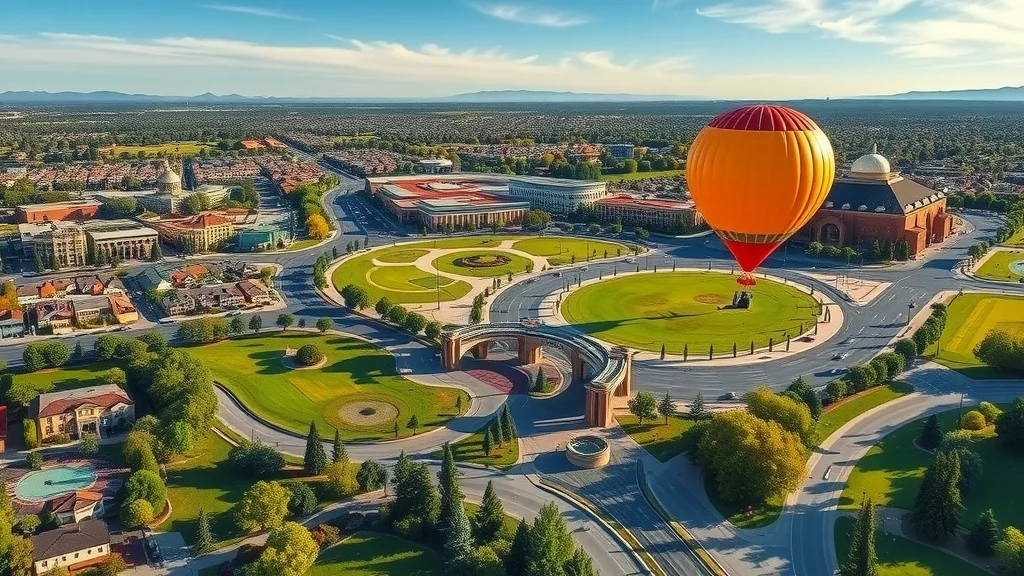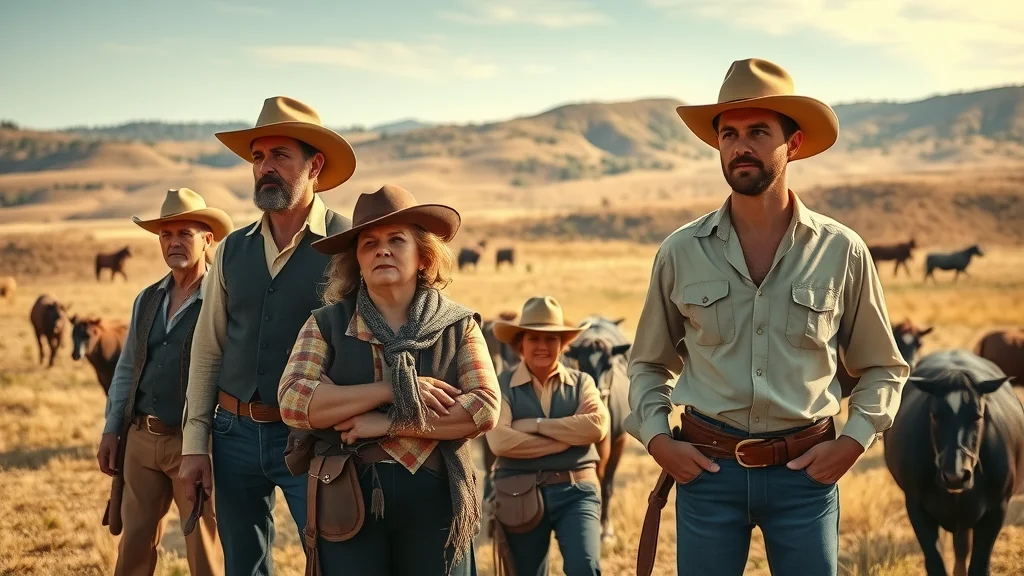Did you know that over 93,000 acres of prime Southern California land—spanning from coastal hills to bustling business districts—was once owned and thoughtfully planned by a single company? The story of The Irvine Company is much more than boardrooms and business deals; it's the tale of a visionary empire that helped shape Southern California’s most iconic destinations. From the rolling ranch lands of the 1800s to the neon-lit epicenters of the present, few people realize just how deeply the Irvine Company's roots run under the streets, parks, and skylines we see today.
A Surprising Start: How The Irvine Company Shaped Modern California
It’s easy to think that Orange County and San Diego’s skylines simply grew over time, but their transformation was carefully orchestrated by The Irvine Company. This visionary group took vast stretches of undeveloped Southern California terrain—once dominated by citrus groves and cattle ranches and helped engineer them into hubs of innovation and culture like the City of Irvine, San Diego’s business district, and more. Their story is a blueprint for how real estate can change not just geography, but entire communities.
"The Irvine Company’s story is deeply intertwined with the transformation of Southern California’s landscape." – Industry Historian
From its quiet beginnings in the 1860s, The Irvine Company turned rural landscapes into bustling centers. In doing so, they pioneered the concept of a master-planned community, a method where neighborhoods, parks, business areas, schools, and roads were developed according to a thoughtful, organized plan, rather than being left to chance.
What You'll Learn About The Irvine Company
The historical roots of the Irvine Company and the Irvine family legacy
Key milestones in the company's transformation from agriculture to real estate
The impact of the Irvine Company on destinations like Irvine Spectrum Center and Fashion Island
Little-known legal battles and ownership controversies
Current influence in markets such as San Diego and Downtown San Diego
The Irvine Company: Roots in Agriculture and the Birth of a Legacy
James Irvine Sr. & Jr.: The Visionaries Behind the Irvine Ranch
It all started with visionaries James Irvine Sr. and James Irvine Jr. In the late 1800s, they acquired what would become the famous Irvine Ranch—stretching across much of today's Orange County. Their goal was to turn this land into one of California’s most productive agricultural regions. The ranch thrived, supplying oranges, lima beans, and other crops, fueling not just regional growth but the foundational economy of Southern California. Their business acumen extended beyond farming: both Irvines understood the value of thoughtful development, planting the seeds for one of the nation’s first master-planned communities.
Their story isn’t just about land, it’s about seeing possibilities. Beneath every citrus grove and ranch house lies a blueprint for future cities, modern commercial real estate, and vibrant communities. The Irvines’ legacy is now cemented in the DNA of the city of Irvine and many neighboring urban centers, showcasing their unique approach to combining productivity with foresight.
From Ranch to City: How Irvine Company Plotted the Future City of Irvine
Development of Agricultural Productivity: The Irvine Ranch thrived as a leading center for oranges, beans, and other crops, fueling the expansion of California’s agricultural industry.
Transition to Master-Planned Community: As patterns of growth shifted after World War II, The Irvine Company realized that Southern California would need organized development. The managers and family plotted a city from scratch, leading to the 1971 incorporation of the City of Irvine, designed for both business and residential life.
Role in Shaping Orange County: The Company was instrumental in drawing roads, neighborhoods, schools, parks, and business districts from former farmland, turning Orange County into one of the most desirable and dynamic regions in the U.S.
Iconic Destinations: How The Irvine Company Created Landmarks
Irvine Spectrum Center: The Story Behind the Entertainment Hub
If you’ve ever driven through Orange County at night, chances are you’ve seen the dazzling lights of the Irvine Spectrum Center. More than just a mall, this centerpiece represents The Irvine Company’s commitment to vibrant mixed-use communities. Born from once-quiet ranch lands, Spectrum Center now pulses with life—entertainment, dining, shopping, and community events. Designed as a commercial magnet, it’s become a must-visit for both locals and tourists, helping to redefine Orange County as a destination for play, not just work. This is a hallmark example of how master planning brings together retail, business, and culture in one energetic hub.
The transformation of empty lots into this entertainment powerhouse required long-term vision. The Irvine Company worked with developers and city planners to ensure that Spectrum Center would seamlessly blend into nearby neighborhoods, integrating offices, residential areas, and green space. The result? A sustainable, people-focused district—one that serves as both a commercial real estate success and a beloved social destination.
Fashion Island and Market Place: Commercial Triumphs and Community Impact
Fashion Island, located in Newport Beach, stands as another testament to The Irvine Company’s flair for creating high-value commercial landmarks. Opened in the late 1960s, this open-air luxury shopping center is not just a place to shop but a Southern California experience in itself, complete with palm-lined promenades, art installations, sunset views, and best-in-class retailers. Its success helped solidify Newport Beach’s status as a global shopping and lifestyle destination, and it continues to evolve, drawing visitors from across Los Angeles and even as far as New York City.
Meanwhile, The Market Place between Irvine and Tustin offers a sprawling array of stores, restaurants, and entertainment venues—strategically planned to serve the growing residential bases of the region. Both Fashion Island and Market Place underscore The Irvine Company’s influence on community life, blending retail, business, and leisure. Their careful location selection and design not only boosted property values but also defined Orange County’s commercial landscape, reinforcing its reputation as a haven for innovation and quality of life.
Expansion Beyond Orange County: The Irvine Company’s Influence in San Diego and Downtown San Diego
The Irvine Company didn’t stop at Orange County. In the 1980s and beyond, it expanded its reach into San Diego, especially in rich urban markets like Downtown San Diego and University City. Here, the company developed high-rise office towers, luxury apartments, and retail complexes that helped revive downtown cores and establish thriving commercial corridors. These investments drew major tech firms and professional service companies, turning San Diego and its neighboring regions into a hotspot for modern commerce and upscale living.
As the downtown skyline grew, so did The Irvine Company’s reputation for establishing and maintaining landmark properties. Their commitment to walkability, green spaces, and mixed-use development made these sites magnets for businesses, families, and entrepreneurs, further demonstrating the company’s impact well beyond its agricultural roots. The reach is even seen in cities north of Los Angeles, as their urban design influence stretches up into Santa Clara and other parts of Northern California.
Little-Known Facts About The Irvine Company’s Growth
The role of Santa Clara and northern expansions: Few realize that while The Irvine Company is mainly associated with Orange County, it quietly acquired significant properties in Santa Clara, contributing to Silicon Valley’s commercial landscape.
The Irvine Ranch’s transformation into a city: The Ranch, once the largest private landholding in California, was master-planned into homes, parks, business districts, and schools—a blueprint copied by developers nationwide.
Philanthropic endeavors: The Irvine Foundation, spun off from the company’s original fortunes, has donated millions to education, the arts, and social causes throughout Orange County and California, leaving a positive mark beyond just buildings and offices.
The Irvine Company: Power, Wealth, and Controversies
Legal Battles: The Irvine Company Lawsuit and Public Perceptions
No history this grand comes without challenges. The Irvine Company has faced a variety of legal battles, from land ownership disputes to commercial zoning controversies. One of the most talked-about topics is the Irvine Company lawsuit—a term often used to refer to disputes over land valuation, development rights, and even disagreements among shareholders and family heirs over time. Though details have varied, these conflicts reveal the complexities of managing immense wealth, public land use, and legacy in California’s dynamic real estate environment.
Public perception often swings between admiration for The Irvine Company’s contributions and criticism over issues like urban sprawl, exclusivity, and the consolidation of market power. The company’s own philanthropic arm has worked to balance this by giving back to the community, but questions remain, especially as the company expands into major markets like San Diego and Santa Clara. Through every lawsuit or zoning debate, The Irvine Company continues to exercise outsized influence over commercial real estate and modern urban planning in the West.
Ownership: Is the Irvine Family Still Involved?
While the company was founded by the Irvine family, today’s ownership structure is more complex. The once family-run business is now overseen by a tightly held group of investors and billionaire leaders. Donald Bren, one of the wealthiest real estate tycoons in the country, acquired full ownership in the 1990s. While the Irvine name remains central to the company’s narrative, most strategic decisions are now in the hands of Bren and his executive team rather than direct Irvine family members. This shift has brought a fresh vision, with an emphasis on sustainability, innovation, and continued expansion into other regions such as West Los Angeles and Santa Clara.
Controversy/Topic |
Description |
|---|---|
Irvine Company Lawsuit |
Details about recent and historical lawsuits, covering land use, zoning, and ownership disputes. |
Ownership |
The status and influence of the Irvine family in corporate governance; modern ownership is controlled by billionaire Donald Bren and a select group of private stakeholders. |
Billionaire Control |
Billionaire involvement, particularly Donald Bren, in driving the strategic direction and long-term growth of The Irvine Company. |
The Irvine Company and its Urban Impact: Downtown San Diego to Santa Clara
Aerial drone footage of downtown San Diego shows the rapid urban growth and high-rise commercial opportunities spearheaded by The Irvine Company.
San Diego: A Growing Real Estate Empire
The Irvine Company has been instrumental in transforming San Diego from a regional port town into an economic powerhouse. By strategically targeting key districts like Downtown San Diego and University City, they fueled a surge in office buildings, luxury rentals, and commercial retail spaces designed for the needs of professionals and families alike. Their properties have attracted major tech firms, universities (like the University of California), and innovative start-ups, reinforcing San Diego’s reputation as a leader in coastal California business and culture.
This expansion didn't occur overnight; it required careful negotiations with local government, an appreciation of the diverse culture of San Diego, and active reinvestment in community amenities like parks and public spaces. By leveraging their experience in Orange County and the greater Los Angeles region, The Irvine Company brought a sense of deliberate planning and organized growth to markets that previously relied on piecemeal development strategies.
Downtown San Diego & Market Place Developments
In the heart of Downtown San Diego, The Irvine Company’s properties regularly rank among the city’s most recognizable commercial and residential spaces. They’ve mastered the integration of retail destinations, such as the Market Place, with residential blocks and community features, making city life more convenient and enjoyable. Their focus on energy efficiency and walkable neighborhoods sets them apart from other large real estate companies and shows how the lessons learned on the Irvine Ranch continue to influence California development to this day.
These downtown and market developments have also set the stage for high-value commercial real estate and innovative public-private partnerships, further establishing San Diego as a competitive business hub parallel to West Los Angeles and even parts of New York City. The Irvine Company’s presence is felt in the city’s skyline, economy, and day-to-day life, showing just how substantial their role is in shaping California’s top destinations.
Santa Clara: Reaching Into Northern California
Many might be surprised to learn that The Irvine Company also has holdings far outside of Southern California, quietly shaping the urban landscape in Santa Clara and the heart of Silicon Valley. Their venture into northern markets came as a strategic move to diversify assets and participate in California’s booming tech corridor. By developing modern office properties and commercial real estate tailored to the needs of technology giants, they cemented their place as influential players not just in Orange County and San Diego, but statewide.
This expansion highlights The Irvine Company’s adaptability, its ability to transplant successful master-planning principles from the sun-drenched hills of the Irvine Ranch to the innovation-driven world of Santa Clara. The result? Thriving business parks, high-efficiency office buildings, and dynamic mixed-use spaces that support tech entrepreneurship and community growth alike.
People Also Ask: The Irvine Company
What does The Irvine Company do?
The Irvine Company is a private real estate development firm known for planning, owning, and managing master-planned communities, commercial office properties, retail centers, and luxury apartments. They have transformed wide areas across Orange County, San Diego, and Santa Clara, helping shape both residential and commercial life in some of California’s most desirable regions.
Does the Irvine family still own The Irvine Company?
While the Irvine family founded the company and led it through its formative years, current ownership is primarily controlled by entrepreneur and billionaire Donald Bren. The Irvine family’s direct influence ended decades ago, though their legacy—and the company’s name—remains a powerful presence throughout California real estate.
What is the Irvine Company lawsuit?
The term refers to a range of legal conflicts involving land rights, zoning issues, or disputes over the company’s enormous assets. Some lawsuits have involved former family stakeholders; others pertain to development strategies, environmental impact, or changing municipal regulations. Despite these legal challenges, The Irvine Company remains a top force in real estate.
Is Irvine owned by a billionaire?
Yes, The Irvine Company has been privately held by billionaire Donald Bren since the 1990s. Bren is consistently ranked as one of the wealthiest individuals in the United States and is known for his long-term vision in real estate, philanthropy, and community planning.
Quotes on The Irvine Company’s Enduring Impact
"Without the vision of the Irvine Company, Orange County would be unrecognizable today." – Local Planner
Key Takeaways: The Irvine Company’s Unique Position in California
Transformed 93,000 acres into modern communities across Southern California
Pioneered master-planned urban living in California, now copied nationwide
Maintains one of the largest private real estate portfolios in the U.S.
Legacy continues through wide-reaching commercial, retail, and philanthropic initiatives
Frequently Asked Questions About The Irvine Company
What is the Irvine Company’s biggest project to date?
The transformation of the original Irvine Ranch into today’s City of Irvine and the development of major commercial centers like Irvine Spectrum Center and Fashion Island are its largest and most influential projects to date.How does Irvine Company’s master planning differ from other developers?
The company’s approach is comprehensive, planning for communities that blend homes, offices, schools, parks, and retail, all designed to work together from the outset for balanced, long-term growth.What has been the social impact of the Irvine Company’s projects?
Through thoughtful planning, the company has created safe, attractive communities, supported education and the arts through philanthropy, and provided thousands with access to modern amenities and green spaces.
Conclusion: Why The Irvine Company Matters More Than People Realize
Whether you live in Orange County, shop at Fashion Island, or work in Downtown San Diego, the lasting influence of The Irvine Company is clear. Through vision, innovation, and sometimes controversy, they transformed California’s landscape for generations to come.
The Daro Digital Team hopes this article has been interesting and valuable to you. Do you have any questions, or would you like us to help your company with Local Marketing and becoming a Trusted Topical Authority in your industry? Send us an email: info@darodigitalmedia.com or schedule a call with us at https://talkwithrob.com
 Add Row
Add Row  Add
Add 



